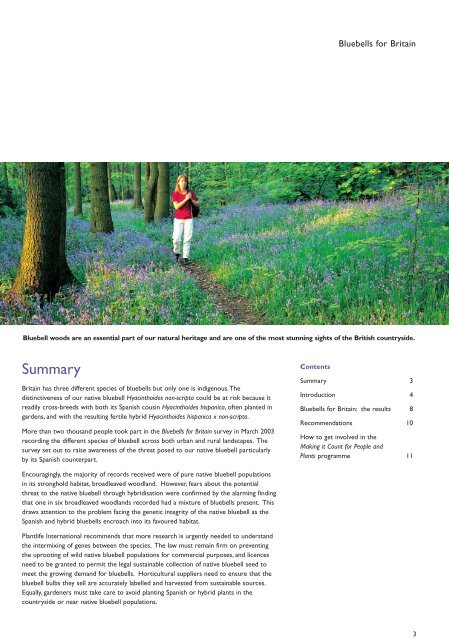Bluebells for Britain - Plantlife
Bluebells for Britain - Plantlife
Bluebells for Britain - Plantlife
Create successful ePaper yourself
Turn your PDF publications into a flip-book with our unique Google optimized e-Paper software.
<strong>Bluebells</strong> <strong>for</strong> <strong>Britain</strong><br />
MARK HAMBLIN/WOODFALL WILD IMAGES<br />
Bluebell woods are an essential part of our natural heritage and are one of the most stunning sights of the British countryside.<br />
Summary<br />
<strong>Britain</strong> has three different species of bluebells but only one is indigenous.The<br />
distinctiveness of our native bluebell Hyacinthoides non-scripta could be at risk because it<br />
readily cross-breeds with both its Spanish cousin Hyacinthoides hispanica, often planted in<br />
gardens, and with the resulting fertile hybrid Hyacinthoides hispanica x non-scripta.<br />
More than two thousand people took part in the <strong>Bluebells</strong> <strong>for</strong> <strong>Britain</strong> survey in March 2003<br />
recording the different species of bluebell across both urban and rural landscapes. The<br />
survey set out to raise awareness of the threat posed to our native bluebell particularly<br />
by its Spanish counterpart.<br />
Contents<br />
Summary 3<br />
Introduction 4<br />
<strong>Bluebells</strong> <strong>for</strong> <strong>Britain</strong>: the results 8<br />
Recommendations 10<br />
How to get involved in the<br />
Making it Count <strong>for</strong> People and<br />
Plants programme 11<br />
Encouragingly, the majority of records received were of pure native bluebell populations<br />
in its stronghold habitat, broadleaved woodland. However, fears about the potential<br />
threat to the native bluebell through hybridisation were confirmed by the alarming finding<br />
that one in six broadleaved woodlands recorded had a mixture of bluebells present. This<br />
draws attention to the problem facing the genetic integrity of the native bluebell as the<br />
Spanish and hybrid bluebells encroach into its favoured habitat.<br />
<strong>Plantlife</strong> International recommends that more research is urgently needed to understand<br />
the intermixing of genes between the species. The law must remain firm on preventing<br />
the uprooting of wild native bluebell populations <strong>for</strong> commercial purposes, and licences<br />
need to be granted to permit the legal sustainable collection of native bluebell seed to<br />
meet the growing demand <strong>for</strong> bluebells. Horticultural suppliers need to ensure that the<br />
bluebell bulbs they sell are accurately labelled and harvested from sustainable sources.<br />
Equally, gardeners must take care to avoid planting Spanish or hybrid plants in the<br />
countryside or near native bluebell populations.<br />
3

















